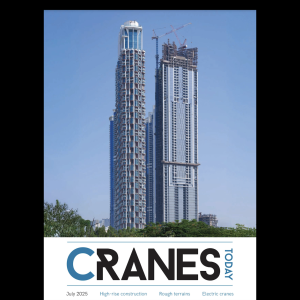
Both cranes use the turbine’s tower as a point of support, allowing them to lift and lower components to greater heights than the equipment that is currently used.
“The wind energy industry is continuously increasing economies of scale to make wind a more cost-effective alternative to other energy sources. For that purpose, wind turbines are getting bigger and higher – reaching physical limits as they become higher than conventional cranes can reach. This also affects the efficiency of wind turbine maintenance activities,” said Mammoet.
Recognising the issue, the company developed two cranes, one for wind turbine assembly and one for wind turbing maintenance.
The 250t WTA 250 is being developed in close cooperation with engineering firm Mecal, with Mecal providing the wind turbine tower design. It is installed on a guiderail that runs along the bottom turbine section and can lift the next section using the turbine’s tower as support. Once the next section is installed and equipped with a guiderail as well, the crane can push itself up along the rail and repeat the process for all of the subsequent turbine sections.
Once construction has been completed, the guiderail can either be removed, or remain in place to facilitate easy access for future maintenance operations. Because the crane uses the turbine’s tower for support, the maximum lifting height of the crane is virtually limitless, says Mammoet.
The 100t WTM 100 is attached to two pre-installed hoisting eyes and can pull itself and the load up along the turbine using the tower for support. It has been equipped with claws that wrap around the tower to keep itself steady. The use of this crane requires minimal modification. It can be used on turbines that have been equipped with pre-fitted hoisting eyes and, in some cases, it can also be used on existing turbines.
At first glance, Mammoet’s WTM resembles some earlier attempts to raise the crane by gripping the tower, such as ITI Energy’s Orangutan and other methodologies. However, as Wessel Helmens, Mammoet innovations director, explained to Cranes Today, Mammoet’s wholly original concept exerts vertical loads which will be taken into account by connection points at the top of the tower, in the direction of the tower's greatest strength. The horizontal forces which will be taken by the two grippers around the tower, are very minimal during maintenance activities.
He says, “Our system will be pulled up by means of winches, and only grips lightly around the tower for precise positioning when it reaches the top. We do not use big forces which could damage the tower.”
“Both cranes are compact – the WTM can easily fit into two standard-sized containers – and the WTA only needs two transport trailers to be moved on site. This makes them easy to mobilize and relocate, and much more efficient than conventional alternatives,” said Helmens. “More importantly, both cranes eliminate the height restrictions for turbines and render both the assembly and replacement process faster and more cost-effective.”
In addition, the cranes offer safety benefits, said Helmens: “Because the cranes are attached to the tower, they have no footprint, making the need for additional ground reinforcements virtually redundant. The tower-based design also puts the crane and the operator closer to the work area, rendering assembly and maintenance both safer and easier.”
Mammoet is currently discussing the first applications of this new technology with their customers. They are also exploring other versions. “Depending on the input from our customers, we may introduce more additions to the WT-series,” said Helmens.






